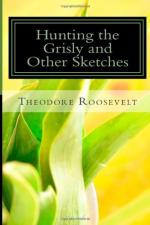These big bears will not ordinarily charge from a distance of over a hundred yards; but there are exceptions to this rule. In the fall of 1890 my friend Archibald Rogers was hunting in Wyoming, south of the Yellowstone Park, and killed seven bears. One, an old he, was out on a bare table-land, grubbing for roots, when he was spied. It was early in the afternoon, and the hunters, who were on a high mountain slope, examined him for some time through their powerful glasses before making him out to be a bear. They then stalked up to the edge of the wood which fringed on the table-land on one side, but could get no nearer than about three hundred yards, the plains being barren of all cover. After waiting for a couple of hours Rogers risked the shot, in despair of getting nearer, and wounded the bear, though not very seriously. The animal made off, almost broadside to, and Rogers ran forward to intercept it. As soon as it saw him it turned and rushed straight for him, not heeding his second shot, and evidently bent on charging home. Rogers then waited until it was within twenty yards, and brained it with his third bullet.
In fact bears differ individually in courage and ferocity precisely as men do, or as the Spanish bulls, of which it is said that not more than one in twenty is fit to stand the combat of the arena. One grisly can scarcely be bullied into resistance; the next may fight to the end, against any odds, without flinching, or even attack unprovoked. Hence men of limited experience in this sport, generalizing from the actions of the two or three bears each has happened to see or kill, often reach diametrically opposite conclusions as to the fighting temper and capacity of the quarry. Even old hunters—who indeed, as a class, are very narrow-minded and opinionated—often generalize just as rashly as beginners. One will portray all bears as very dangerous; another will speak and act as if he deemed them of no more consequence than so many rabbits. I knew one old hunter who had killed a score without ever seeing one show fight. On the other hand, Dr. James C. Merrill, U. S. A., who has had about as much experience with bears as I have had, informs me that he has been charged with the utmost determination three times. In each case the attack was delivered before the bear was wounded or even shot at, the animal being roused by the approach of the hunter from his day bed, and charging headlong at them from a distance of twenty or thirty paces. All three bears were killed before they could do any damage. There was a very remarkable incident connected with the killing of one of them. It occurred in the northern spurs of the Bighorn range. Dr. Merrill, in company with an old hunter, had climbed down into a deep, narrow canyon. The bottom was threaded with well-beaten elk trails. While following one of these the two men turned a corner of the canyon and were instantly charged by an old she-grisly, so close that it was only by good luck that one of the




